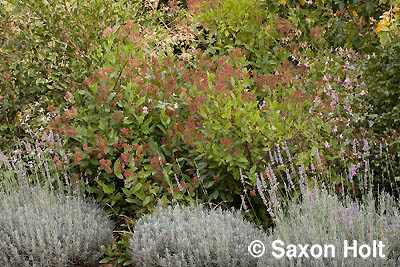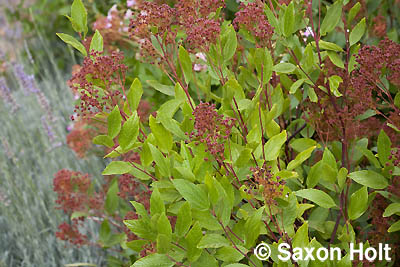Sometimes we look at our garden successes and wonder how to photograph it. What is the essence? What makes it work? I walked down my driveway this morning where I have a mixed shrub border and once again fell in love with Ceanothus ‘Marie-Simon’.
While I like this straight on photo, composed to evoke the shrub tapestry that I am attempting in my border, it is not the essence. How do I find that photo? What is about this plant that works so well for me? How to communicate ?
First, I think it is important to know what it is we want to say with our photos. If only a memory jog or a documentary photo for our own scrapbook, almost any photo will do. Our memory and cognitive systems will allow us to re-live the scene even if the photo barely reminds us of the beauty. But when we want to share the photos, communicate to others, or in my case sell them, the photographer needs to get to “the thing”.
Here, in this detail photo, we begin to see what grabbed my attention today. Ceanothus x pallida ‘Marie-Simon’ is one among the group of French hybrid, deciduous California Lilacs that are appreciated only by gardeners. Now is not the time to discuss how many of our native plants, whose potential as garden plants have been recognized by gardeners in other countries, are overlooked even while we as a culture are supposedly looking for sustainability.
Ceanothus (California Lilacs) are, or should be, one of the backbone shrubs of any California garden. Tough, dependable, and drought tolerant they provide profuse trusses of spring flowers born on terminal branches much like traditional Lilac (Syringa). But what is so extraordinary about the French hybrids are the red stems, delicate green leaf coloration even in hot, dry summer, and, in the case of ‘Marie-Simon’, the beautiful seed pods from the faded flower trusses persist for months.
Now this next photo is getting to the essence of what I see when I look at ‘Marie-Simon’ in my border. Her seedpods are very ornamental: mahogany-red, not gray-brown like so many shrub seedpods. These red splashes of texture are what I see in the garden (first photograph) as I walk by. To capture that, to find the photograph in the garden that communicates well, I go to the essence of the scene – the close-up of the seedpod itself.
As I work the scene and look for the best angle to isolate the faded flower truss, I find I need to set my tripod in the border amongst the lavenders. This allows me, with selective focus, to compose an image at once simple but sophisticated because of the complimentary colors.
Isolating the Ceanothus in front of the lavender is done carefully in the viewfinder of the camera and is a big reason photographers need to use tripods. Slowing down the picture taking process allows for careful composition and thinking about “the thing” we are trying to capture in our image.
This is not about making the camera “lie” or making the garden seem better than it really is, it is about getting to the essence. Our sensory impressions of the garden are made up of many details, what we say with or camera can only do so much. To find the photo in a garden scene that captures our successes one must consider carefully what we want to say.
I could say “tapestry” as in the first photo or I can say “colorful seed pods” as in the detail. What I can never do is truly capture the garden. In standing in my lavender hedge to take the picture I released fragrances that linger on my trousers now. It was a marvelous cool day. I had fun in my garden. Does a photo show that essence to anyone but the photographer who was there ?




